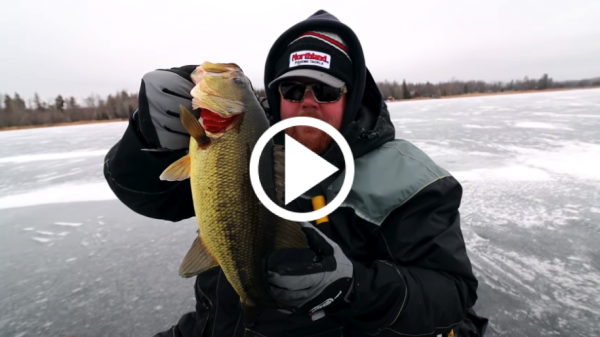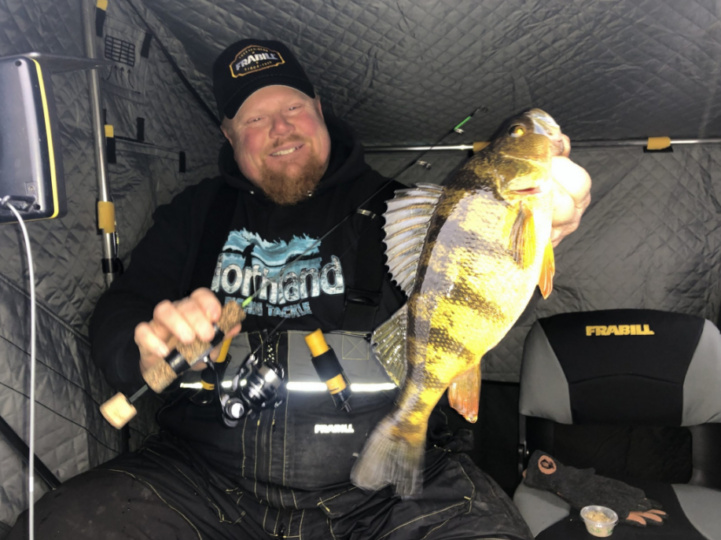January can be many things, but cold is always one of the biggest variables across the Ice Belt. The other big variables are ice quality and the amount of snow on the lakes.
January is almost always the coldest month of the year and the lakes can be buried in snow or covered with thick ice—or usually both at some point in the month.

Midwinter patterns usually mean many fish are close to the basin, with some on the edges of the structure, and others either suspended over the basin or close to the bottom, feeding on minnows and the insect base of the lakes. There can also be other fish still in the weeds, and still more fish on the structure. The usual scenario in my part of the country is there are some fish using most of the patterns to some degree.
Aqua-Vu’s Micro 5 Revolution Pro is my tool for finding green weeds.
January is usually the big month of winter for the big lakes. The resorts are in full swing and their rental houses are mostly full if they are doing things right and are on fish.
If anglers want walleyes, big pike, sauger, and jumbo perch in my part of the country, nobody does it better than Lake of the Woods. They have a distinct dual advantage, due to the number of fish and the stained water, so they can get a good day bite much of the winter.
There are also Winnibigoshish, Cass Lake, Pike’s Bay, Leech Lake, Upper Red Lake, and many other medium and smaller lakes in my area, so Lake of the Woods is not the only show in town,
Devil’s Lake, Mille Lacs, Green Bay, and other lakes in states surrounding Minnesota are also making hay during the coldest part of the winter. It is their busiest month and most dependable ice and provides a good part of their winter income.
Minnesota, the Dakotas, Wisconsin, Iowa, and Michigan concentrate on fishing with Humminbird Helix 8 w/Mega 360 Imaging for checking if bottom-dwelling perch & walleyes are in the area. It has a hands-free transducer that scans around you all the time.
Anglers use anything from a wide range of finesse techniques to dead sticks, depending on the regulations and the species they are trying to catch. In other parts of the country on the edges of the Ice Belt, anglers rely more on fishing tip-ups and set up more of a trap line than intensively fishing one rod.
Fish Monkey Stealth Dry Techgloves are my go-to tip-up gloves. They’re light, warm, waterproof gloves that help you control your tip-up line.
There has been a huge boom in the ice fishing industry with the continuing advancement of portable fish houses for increased utility and mobility, both in the canvas versions and the wheeled versions of fish houses.
I am one of the few guides that use portable houses for my clients, but having a couple of stationary houses is always a bonus, especially for that evening bite where you want to be on the spot and ready for the flurry you are hoping is coming.
I am always on the move during the day, moving clients as becomes necessary, considering the bite and the conditions of the day. This can include changing locations, changing lakes, and even changing species. I work hard for my clients and do my homework, which may explain why I am as busy as I want to be.
I rely heavily on Frabill for my portable fish houses and have significant input into the design and function of the houses, so they are the ones that work best for me and my guiding.
There are so many factors to a good fish house. Ease of setup. How they tow, how they haul, warmth, durability, weight, stackability, interior space, floor space for the ice, and bang for your buck. The design aspects go on and on, with many more considerations than most anglers realize.
The same is true for Northland Tackle. I have helped design many of their lures for ice fishing. I see how lures work. The bottom line is how they catch fish. I see the drawbacks and advantages of lures and am always thinking of ways to make them more functional and effective for the fish I want to catch. Northland is very receptive to my ideas and the product lines have always been some of the best producers on the market. Recently, I’m excited about their Glo-Shot Fire-Belly Spoon & Rattlin’ Puppet.
I guide several species in the lakes around my home in Max, Minnesota, but my fishing interests run the whole gambit from freshwater to saltwater. I even fish for my own bait when I have time. Those who know me best say I am addicted to getting bites, and I would honestly have a hard time denying that.
I also have a bit of an alternative mindset that doesn’t like to hear this doesn’t work you can’t do this or can’t do that. I try to keep it real and take great pleasure in doing my own thing and figuring things out from scratch. This doesn’t mean I don’t listen and watch very closely. I have learned from the strangest situations and usually pay more attention than it may look.
I guide for walleyes, perch, and crappies during the winter. I generally fish structure or the basin’s edges for walleyes during January. I have a long memory of guiding ice fishing, so the reservoir of knowledge of spots in my head is pretty extensive. I am always drawing on many years of patterns and try to look at each year as a combination of things I have seen before.
Perch ebb and flow with the year. Good age classes move through lakes, so it is not the same thing year after year. It is usually a matter of figuring out which lakes have a good population of fish that will be acceptable to the customers. Most perch are in the basin, feeding on the insect base during January.
Crappies like mud because of what they eat. Many anglers mistakenly say the crappies are in the deep holes. This is usually true, but it is not the deep water that draws the fish. It is the mud basin. This includes the shallow to the deep basin, so the right kind of mud is the bigger key to their location.
Ice fishing is the perfect setting for enjoying the outdoors and helping enjoy the different seasons of the year. Whole families love it and you might love it, too. Give it a try this winter.
Credit to Midwest Outdoors.


